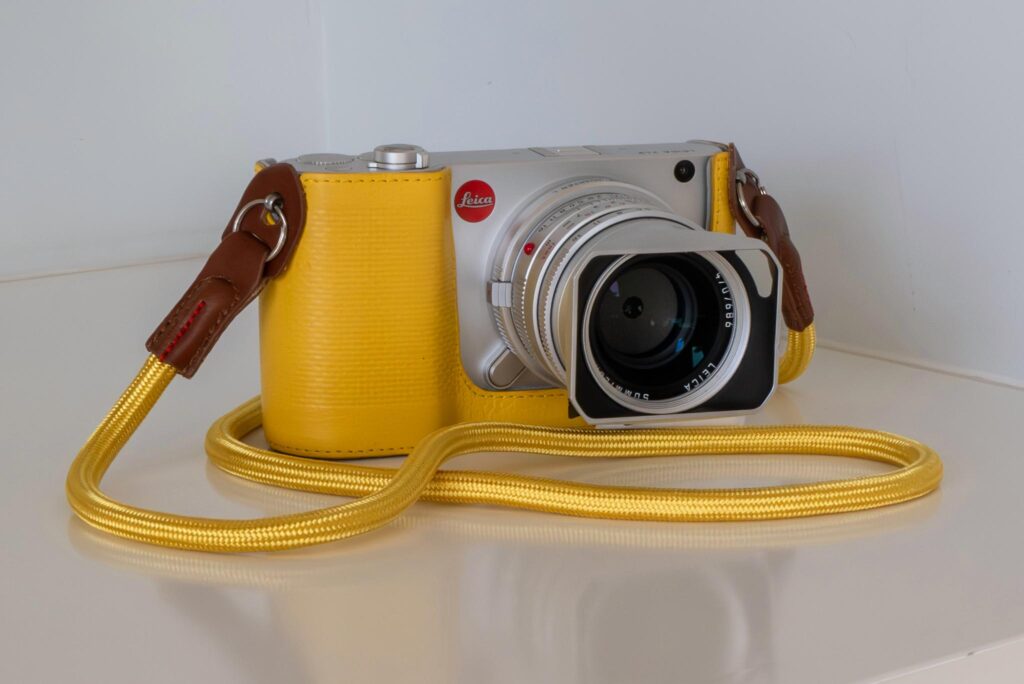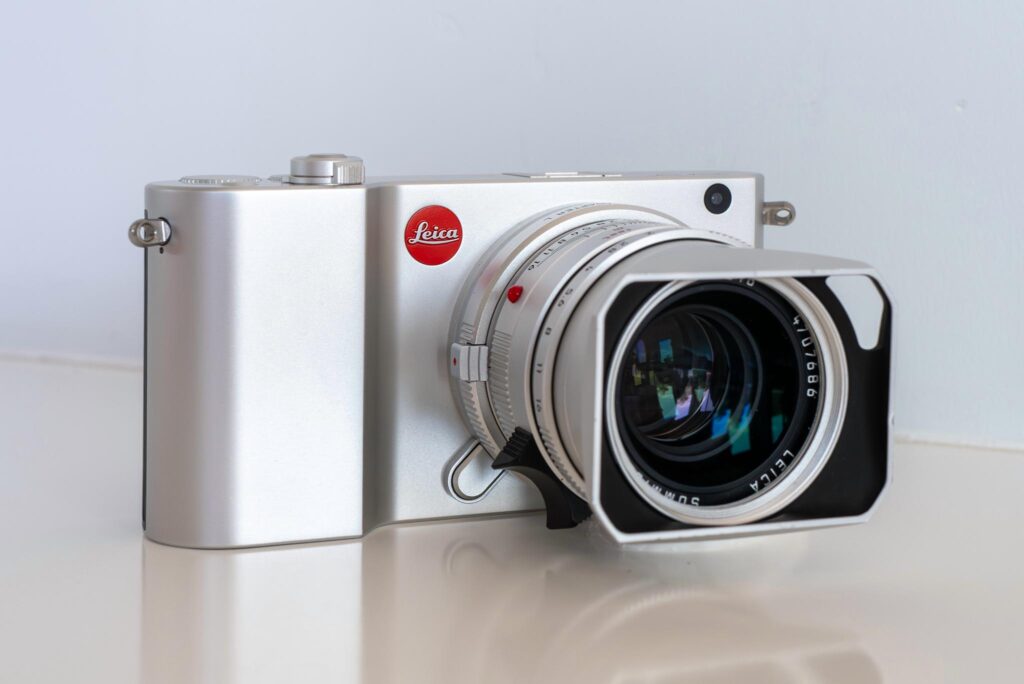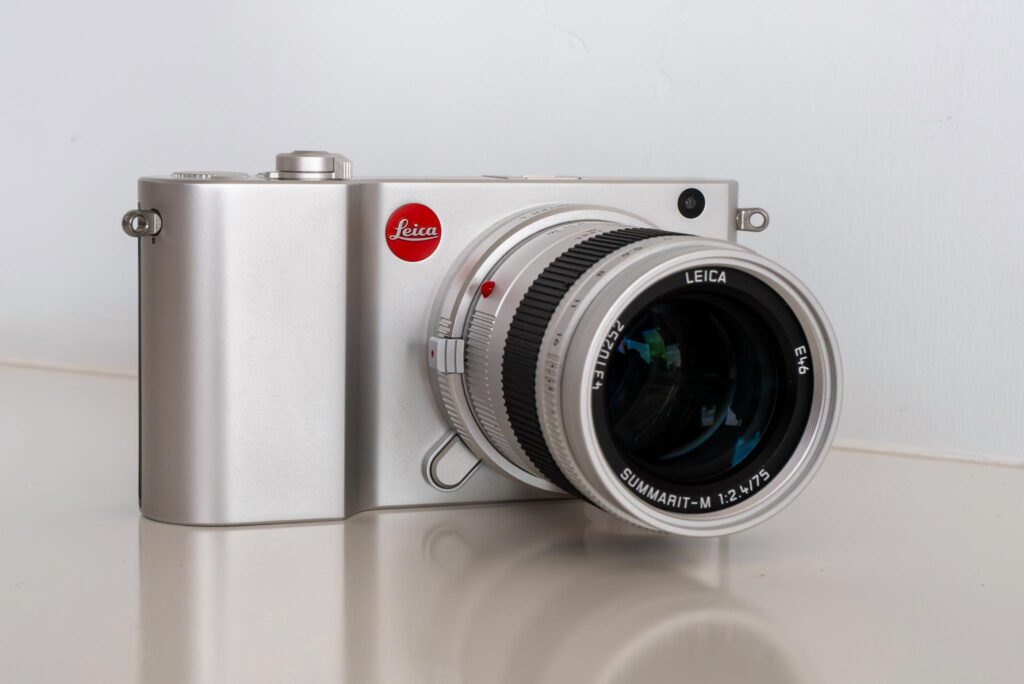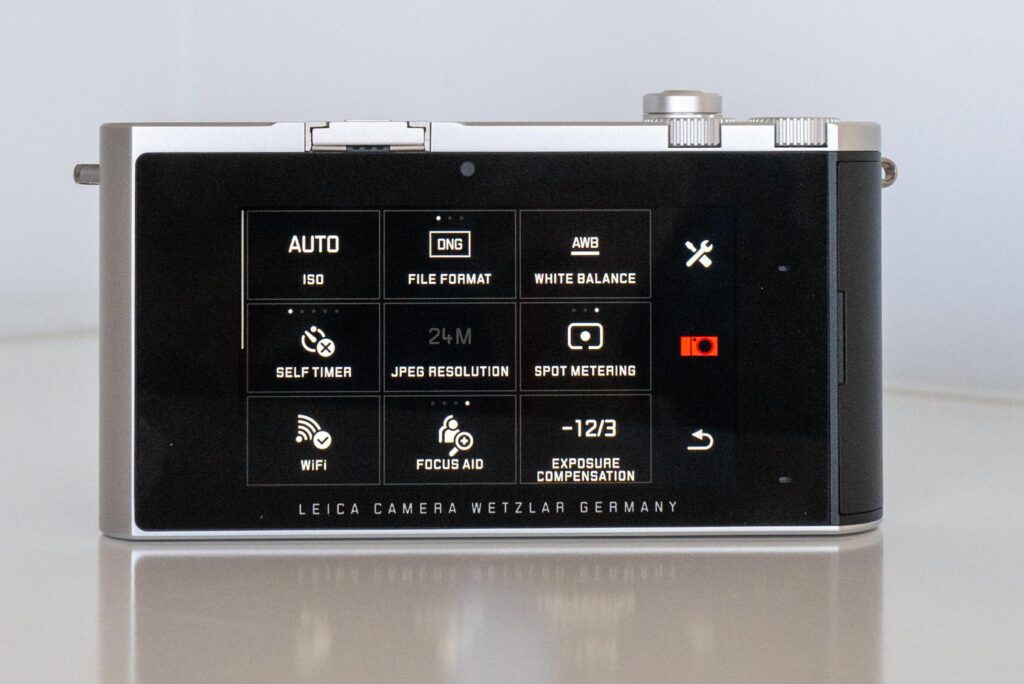Anyone entering the rangefinder world should expect to shell out for a decent lens or two. If those are Leica lenses, they might cost as much as or more than the camera itself, even if they are second-hand. Doesn’t it make sense then to make the most of those stellar prime lenses, wringing every ounce of value from them? That was my plan, and why I turned to a two-body, two-lens kit.
Let’s rock ‘n’ roll
When devising a budget for an interchangeable-lens-camera (ILC) system, what percentage would you allocate to lenses versus body?
Fifty-fifty?
Probably not.
Assuming you would likely purchase lenses covering a range of focal lengths, they are going to dominate your budget. After all, aren’t lenses what it’s all about? They do the hard work of translating a scene into a focused pattern of rays projected onto a flat plane.
Isn’t the body just a means of capturing those rays, on film or digital sensor? I suppose it does make some additional contributions, such as aiding with focus, and storing the resultant images. But, wouldn’t you rather spend your money on great lenses and a decent body, rather than the other way around?
In previous articles, I described my tentative steps into rangefinder photography and my approach to building a minimalist kit. I remain delighted with my choices. To complement my (admittedly, loud) red-leather-clad camera, I recently added a custom accessory from Rock n Roll Straps. The team kindly made me a red-rope strap with red-leather finishing, rather than the regular black. This has further increased the frequency of compliments and enquiries I receive from passers-by when out with my camera. It’s nice to be the centre of attention…
My two lenses, a 35mm f/1.4 Summilux, and a 75mm f/2.4 Summarit, continue to perform superbly. Both, bought used, are so small and light, especially compared to my 50mm f/2.0 APO Summicron SL. Although requiring manual focus, the attraction of these petite M-lenses had now become clear to me. So, I began to consider how I could put them to use, beyond just my M240 set up.
I hate to mention it but…
As a regular Macfilos reader, I am painfully aware of the controversy, or should I say outrage, surrounding Leica’s withdrawal from the APS-C market. Since I did not own a Leica APS-C camera, I had been merely a bystander to this unfortunate development.


Left, 35mm lens and full-frame sensor. Right, 35mm lens and APS-C sensor


Left, 75mm lens and full-frame sensor. Right, 75mm lens and APS-C sensor
However, it dawned on me that with an M-to-L adapter, I could use my M-lenses on a Leica APS-C camera. This would switch their effective focal lengths, giving me access, as if by magic, to new ‘50mm’ and ‘110mm’ lenses, give or take the odd millimetre. Even more tempting, since these cameras are no longer in production, was the prospect of used models at discount prices.
My initial thought was to look for a Leica CL. Based upon countless articles and comments, it is clearly a very highly regarded camera. But, a small nudge from a veteran Leica owner prompted me to consider a TL2.
A two-lens, two-body kit?
As I looked into it, I decided the TL2 was a remarkable camera that I would love to own. Its slim body, machined from a single block of aluminium, is a minimalist objet d’art—especially the silver version. Here are two reviews of the TL2, by Jonathan Slack and Thorsten Overgaard, produced around the time of launch, in 2017.
It appears Leica introduced the T-series to reflect how people were increasingly preferring to take photos. That is, using a smartphone, whose screen is used to compose the photograph. The T-series cameras thus employed a body-length, touch-sensitive rear screen, through which camera controls are accessed and photos composed. The only physical controls on the TL2 are: on-off switch, shutter-release, programmable function button, and two parameter-selection wheels.

There is much more information available in the linked reviews and online. Suffice it to say that the TL2 represented a radical change in Leica camera design. The company deserves credit for the risk it took in launching such a device.
Unfortunately, it was not a commercial success. Commentators attributed this primarily to its lack of built-in electronic view finder (EVF) and exclusive reliance on that rear screen.
Leica announced its decision to discontinue production of its APS-C line of cameras, including the TL2, in May 2022.
Gone but not forgotten
Used Leica TL2s are still readily available online. So, I bought one. Yes, I handed over my hard-earned cash for a discontinued camera. As alluded to above, I had several reasons for buying a device which is, in effect, obsolete.
Firstly, a TL2 equipped with an M-to-L adapter does indeed give M-lenses a second identity. Each of them gains a 1.5x increase in effective focal length. Furthermore, TL2s can be purchased used, in excellent condition, for considerably less than $1,000. Compare this to the cost of any other Leica camera or lens you can think of. For me, it’s been a very cost-effective way of expanding the utility of my small collection of prime Leica M-lenses.
Secondly, the silver TL2 is a sensational example of modern design. I was not surprised to learn that it is considered a leading example of 21st century functional art. The T-series received an iF Design Gold award, and a ‘Best of the Best’ award from Red Dot Design. It is a gorgeous piece of photographic kit, and a perfect body on which to mount silver-finish lenses. It is a pleasure both to stare at and to grasp.
Ahead of its time
Finally, the TL2 offers a very different shooting experience from most enthusiast-level, mirror-less cameras. It is iPhone-like photography, but with superb interchangeable lenses, and a far superior sensor. Most of us are taking photos with our phones, framing the scene by looking through the phone’s screen. We are also opening apps and making selections using the touch screen. Why not use a ‘real’ camera that way?
As a brief aside, I was at a recent event where students were wandering around taking photographs with Canon and Nikon cameras. Guess what? They were all snapping away, looking at the camera’s rear screen. No-one was looking through a viewfinder. This iPhone-age generation clearly saw that as a more intuitive way to take photos.
Perhaps the TL2 was just ahead of its time.
My two-body kit
So, how am I using this two-lens, two-body kit? And what is the impact of swapping lenses between these two different sensor sizes?


Left, 35mm lens and full-frame sensor. Right, 35mm lens and APS-C sensor


Left, 75mm lens and full-frame sensor. Right, 75mm lens and APS-C sensor
I have included a few field-of-view comparisons in this article. As you would expect, there is a clear narrowing in field-of-view from 35mm through ‘50mm’ and 75mm, to ‘110mm’. Until seeing these comparisons myself, I had not appreciated how different these perspectives were. Although in principle, one could achieve these changes via digital zooming, these photographs were all taken with a prime lens using a full 24 megapixel sensor.
How does swapping between sensors impact depth-of-field (DoF)?
It’s complicated
DoF is one of the more complex photographic topics, and a detailed discussion is well beyond the scope of this article. My specific interest was the DoF resulting from, say, a 50mm lens / full-frame (FF) set up, compared to the DoF resulting from a ’50mm-equivalent’ / APS-C set up. That is, for a given aperture and subject distance, was the DoF produced by the ’50mm’ I had created by mounting my 35mm lens on an APS-C camera, the same as, or different from the DoF produced by a 50mm lens on a FF camera?
I have consulted several experts on this question, as well as read a number of articles. I found a three-part series of articles by Todd Vorenkamp of B&H particularly helpful. Here is a link to the first in the series. He provides both a clear description of the key concepts, as well as a detailed mathematical explanation of how DoF is calculated. He also provided a perfect example of the comparison I was interested in.
And the answer is…
Since the source of the information is based in the United States, distances were provided in feet and inches. I know…
For a 75mm lens on a FF camera, at an aperture of f/2.8 and subject distance of 5.9 ft, the DoF is 3.4 inches.
What about a 50mm lens on an APS-C camera, where the 1.5x crop factor yields the equivalent, i.e., “75mm” field-of-view?
For a 50mm lens on an APS-C camera, at an aperture of f/2.8 and subject distance of 5.9ft, the DoF is 5.6 inches.
Bingo! The ’75mm-equivalent’ set up has a slightly wider depth of field, by ~1.5x
So, using the ’50mm-equivalent’ field-of-view generated by my 35mm Summilux on my TL2, I will have a slighly wider DoF than if I used a 50mm Summilux on my M240.
My view is that this minor difference is insignificant in the real world, where I will be selecting subject distance and aperture to achieve a specific compositional objective. The shot above was taken using my ’50mm-equivalent’ set up. I hope you’ll agree that it is interesting because of the framing and timing of shutter release, not because of subtleties of DoF!
Here’s an image exploiting DoF, this time using my ‘110mm’ set up, shot wide open at f/2.4. Estimating the subject distance to be ~9 metres, the calculated DoF is ~1.3 metres.
In this part of her performance, the acrobat rotated slowly about a vertical axis. I pressed the shutter-release when she was almost parallel to the sensor plane. Consequently, her image is sharp, toe-to-toe, and nicely separated from the background.
Focusing the TL2
The TL2 has a very useful and easy-to-use focus-aid system. This it activated by rotation of the left-hand parameter control wheel with one’s thumb. It brings up a 3x, or with further rotation, 6x magnification of the subject on the rear screen. Fine adjustment of the focus ring in this mode delivers a sharp image when the shutter is released.
Late Summer Hibiscus and Dahlia. Leica TL2, M-to-L adapter, 35mm Summilux
With a little practice, sharp focusing on moving objects is also straightforward, provided they are not moving too quickly.
All the fun of the Fair. Leica TL2, M-to-L adapter, 35mm Summilux
Field-of-view comparisons
In the two previous articles in this series, I made passing reference to the 50mm focal length, and how it was one of the two most popular focal lengths selected by rangefinder shooters, the other being 35mm. I now have experience of both focal lengths, courtesy of my two-body arrangement and 35mm Summilux.


Left, 35mm lens and full-frame sensor. Right, 35mm lens and APS-C sensor


Left, 75mm lens and full-frame sensor. Right, 75mm lens and APS-C sensor
To my surprise, I found the field of view generated by the ‘50mm’ lens very useful. I could frame subjects, such as buildings, groups of people, and even individuals, successfully while a reasonable distance from them. I can see myself using this set up regularly as a ‘walk around’ photography option.


Flying objects: left, great blue heron, right, SouthWest flight on approach. Leica TL2, M-to-L adapter, 75mm Summarit
However, I am much less likely to use the ‘110mm’ focal length. Although not a wildlife photographer, I do occasionally come across birds, such as the great blue heron above. In these situations, the longer focal length option is very handy. But in general, I think I will reach for it less often than the other focal lengths.
Travelling with a two-lens, two-body kit
The very slim profile of the TL2 means I can easily slip it into a small camera bag, such as a Billingham Hadley Small, along with the M240 and two lenses.

I bought a fitted leather protector for the camera, for use when I carry it on a strap around my neck. Unfortunately, these are now hard to come by.

As someone who enjoys bright colours, I snagged a yellow one, and found a matching strap online. Note to self: need to find a yellow-rope strap with yellow-leather finishing.
Cheating a little bit
I realise that this article has not really been focused on rangefinder photography. Rather, it has been focused on lenses used on rangefinder cameras, and one approach to maximizing their utility. Since I have an M-to-L adapter, I have also experimented with using them on a Leica SL2. The superb electronic viewfinder and focus peaking on that camera makes manually focusing these lenses a breeze. That’s a story for a separate article, though.
Would you consider buying a discontinued camera model? Have you had any experience with a TL2? Have you tried using it with M-lenses? Please let us know in the comments below.
Read more from the author
Here’s the first article in this series
And here’s the second article in this series
Join the Macfilos subscriber mailing list
Our thrice-a-week email service has been polished up and improved. Why not subscribe, using the button below to add yourself to the mailing list? You will never miss a Macfilos post again. Emails are sent on Mondays, Wednesdays, and Fridays at 8 pm GMT. Macfilos is a non-commercial site and your address will be used only for communications from the editorial team. We will never sell or allow third parties to use the list. Furthermore, you can unsubscribe at any time simply by clicking a button on any email.


















Instead of A CL you could acquire a PIXII wgioch has an M Mount
Hi Jonathan, many thanks. A PiXii would indeed keep me in the rangefinder world and give me that APS-C crop, but without having to use an M-to-L adapter. Tempting! Perhaps down the road, when their platform is more established, it would be worth a look. I just checked and found a used one online at a modest discount. I suppose there will be more available as time goes by. All the best, Keith
I bought a used CL last year and it’s become my every day carry. I love it. Good idea to use it in combination with an M. I hadn’t thought of it in that way but that makes perfect sense.
Hi David. I have never used a CL, but would love to try one. Equipped with an M-to-L adapter, it would seem to be the closest thing to an M-with-built-in-EVF that many Macfilos readers would like to see. Now owning an APS-C camera, I better appreciate the difficulty of achieving a wide-angle field-of-view using full-frame M-lenses, because of the 1.5x crop factor. A CL with a full-frame sensor would of course address that limitation. All the best, Keith
Great article Keith – and great pictures – it even had me scamperting around looking for a TL2 body – if you’re going to use it with M lenses I think it’s nicer and more interesting than a CL . . . and of course the faster AF of the CL is irrelevant!
Hi Jono – many thanks! I love my TL2, and I am having great fun using it. The touch-screen menu system is so slick – so easy to tweak exposure compensation, ISO, metering etc. I also find the focus-assist-magnification very easy to deploy. So far, its only shortcoming has been battery life – the inevitable consequence of this extremely svelte body, I suppose. All the best! Keith
Keith
Thanks for a well written article filled with envy worthy images.
I have to admit I cringed when I got to the section about depth of field. I was pleased to see that your expectations and explanation were spot on. The Marketing Departments of the camera companies have convinced most people that sensor size determines depth of field.
Concerning your important question; Have I ever purchased an old obsolete camera? Absolutely! Several times in fact.
My most out of the box, and most spontaneous and expensive purchase was buying a Leica R3 body to go with a Leica 100mm f2.8 Macro R (ROM) lens that my local dealer had in the used case. I had a long running lust for the lens and decided if I ever found one I was going to get it. Which meant I also had to buy a body to go with it; I only had M equipment at the time.
PaulB
I think you have a brilliant kit. A person can take amazing images with almost any camera made in the past 10 years. The TL cameras were brilliant if you do not need a viewfinder. I need a viewfinder so was never tempted.
I used to own micro 4/3, hasselblad X1d , and Leica SL all at the same time. All created amazing images but a minor stress sorting out depth of field at times. I have been using the iphone apps TruFof-pro and optimum CS app made by the same competent person for years They are brilliant and you can pick various technical settings such as sensor specs. Try it, you will love it. You can adjust setting until you get effect you are looking for. Glass can have different depth of field fall off characteristics from fast to slow. Leica glass is usually fast due to micro contrat. Depth of field is not an exact science ..
Hi Brian, many thanks for commenting, and for the great suggestion! I will definitely check out those apps. All the best, Keith
I’m looking for Marilyn and Tony Curtis on the beach ..there, in front of the hotel ..had they left when you arrived? (..’Some Like It Hot’.)
By the way, you say “Bingo! The ’75mm-equivalent’ set up has a slightly wider depth of field, by ~1.5x” ..perhaps it may be a bit less confusing to say “Bingo! The ’75mm-equivalent’ set up has a slightly greater [or deeper] depth of field, by ~1.5x” ..because ‘wider’ seems to imply a broader – left-to-right – image area ..i.e; greater width of the resultant image ..we-ell, to me, anyway.
A simple rule of thumb: any lens – e.g; any 50mm lens – always has the exact same depth of field (..at the same aperture..) on any film or sensor. So your 50mm lens on an APS-C camera ..or on a ‘full-frame’ or any other size sensor..! ..at an aperture of f/2.8 and subject distance of 5.9ft, will always have the same DoF of 5.6 inches. The d-o-f is a characteristic of the lens and the aperture it’s used at, no matter what device it’s attached to.
Nice pictures, by the way!
Hi David, many thanks. Yes, Tony and Marilyn had already left by the time I showed up – some 60+ years ago apparently…
It seems many adjectives are used to describe DoF: shallow, narrow, short, long, deep, wide. As you say, it depends on one’s mental diagram of the relationship between a subject, lens and sensor. I picture it ‘side on’ with subject on the left, and sensor on the right, and so the DoF indeed gets wider in my world.
As I mentioned in the article, DoF can be complicated. The author of the series of articles to which I referred compares DoF for a given lens at a given aperture on different sensors, and demonstrates mathematically that the DoF changes according to sensor size. However, exactly how much depends on whether the camera-to-subject distance stays the same, or whether the camera with a cropped sensor is moved further away from the subject in order to maintain the subject size in the frame.
The main point that interested me was comparing the DoF achieved using, say, a 35mm lens on an APS-C sensor versus a 50mm lens on a FF sensor.
Cheers, Keith
Gee whizz, Keith ..I just looked at those Todd Vorenkamp articles about depth of field, and all that crazy maths (English, plural) drove me nuts! It’s unnecessarily over-complicated ..for a simple mind like mine, anyway!
If I want to see what depth of field I’ve got on an M240 (your rangefinder camera) or a TL2 (your APS camera) with whichever lens I use ..I look at the image on the screen on the back of the camera! ..That shows me what’s in focus and what’s not.
I’d better go and have a cup of tea now, to recover.
Thanks Keith, this is very informative. Buying M lenses for dual use is certainly a way to amortize the cost, but you still need to add the cost of additional lenses! I borrowed a 35 Summicron and an M-L adaptor a while back for my CL and found it difficult to get a bright enough view in the EVF. I never tried the LCD viewing as I’m not young enough for that. We (DT and I) agreed that the lens may not have been coded so might have caused that issue.
Bearing in mind your setup and my preference for wider than longer lenses, I would probably go 28/35/50 for dual use. “Now how much is that going to cost you?” enquires Her Ladyship…Over to you Keith!
Thanks Jon! Perhaps you can use an argument along the lines of…”imagine how much I save by buying just three lenses – 28mm, 35mm, and 50mm – rather than five lenses – 28mm, 35mm, 42mm, 50mm, and 75mm…” All the best with that one!
By the way, I did not know that DT (Donald Trump) knew so much about lens coding…
Cheers, Keith
Ha! Dan Tamarkin!
I note with interest you have a 75mm Summarit, a good choice. I also use one on my M10M and also an SL2. This is a very underrated lens and IMHO is just as sharp as the 75 APO Summicron M, just a bit slower at max aperture. Without the hood it is marvelously small. In spite of the fact that it is a less expensive lens it is very solid and the silver version is elegant to say the least.
Hi Bill – I couldn’t agree more – the 75mm Summarit is a fantastic lens. For a short telephoto it is extremely small and light, and is impressively sharp, even at f/2.4. I am delighted with it. All the best, Keith